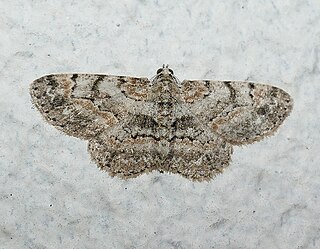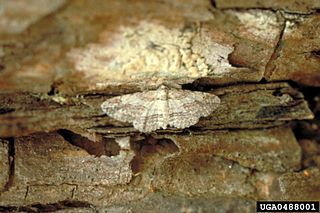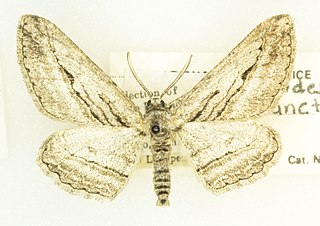
The luna moth, also called the American moon moth, is a Nearctic moth in the family Saturniidae, subfamily Saturniinae, a group commonly named the giant silk moths.

The cinnabar moth is a brightly coloured arctiid moth found as a native species in Europe and western and central Asia then east across the Palearctic to Siberia to China. It has been introduced into New Zealand, Australia and North America to control ragwort, on which its larvae feed. The moth is named after the red mineral cinnabar because of the red patches on its predominantly black wings. The species was first described by Carl Linnaeus in his 1758 10th edition of Systema Naturae. Cinnabar moths are about 20 mm (0.79 in) long and have a wingspan of 32–42 mm (1.3–1.7 in).

The brown-tail moth is a moth of the family Erebidae. It is native to Europe, neighboring countries in Asia, and the north coast of Africa. Descriptions of outbreaks, i.e., large population increases of several years duration, have been reported as far back as the 1500s. The life cycle of the moth is atypical, in that it spends approximately nine months as larvae (caterpillars), leaving about one month each for pupae, imagos and eggs. Larvae (caterpillars) are covered in hairs. Two red spots on the back, toward the tail, distinguish these species from other similarly hairy moth larvae. The winged adults have white wings and a hairy white body with a tuft of brown hair at the tip of the abdomen. Females lay one egg cluster, usually on the underside of a leaf of a host plant. The species is polyphagous, meaning that it feeds on many different species of trees, including pear, apple, maple and oak.

The Limacodidae or Eucleidae are a family of moths in the superfamily Zygaenoidea or the Cossoidea; the placement is in dispute. They are often called slug moths because their caterpillars bear a distinct resemblance to slugs. They are also called cup moths because of the shape of their cocoons.

Spodoptera littoralis, also referred to as the African cotton leafworm or Egyptian cotton leafworm or Mediterranean brocade, is a species of moth in the family Noctuidae. S. littoralis is found widely in Africa, Mediterranean Europe and Middle Eastern countries. It is a highly polyphagous organism that is a pest of many cultivated plants and crops. As a result, this species was assigned the label of A2 quarantine pest by the EPPO and was cautioned as a highly invasive species in the United States. The devastating impacts caused by these pests have led to the development of both biological and chemical control methods. This moth is often confused with Spodoptera litura.

Anacamptodes is a genus of moths in the family Geometridae erected by James Halliday McDunnough in 1920. There are around 40 species within the genus, although a number have been reassigned to the genus Iridopsis.

Iridopsis is a genus of moths in the family Geometridae first described by Warren in 1894.

Iridopsis ephyraria, commonly known as the pale-winged gray, is a species of moth in the family Geometridae. The species was first described by Francis Walker in 1860. It is found in the United States and southern Canada east of the Rocky Mountains, from New Brunswick to Florida, west to Texas and north to Alberta.

Iridopsis pergracilis, the cypress looper moth, is a moth of the family Geometridae. The species was first described by George Duryea Hulst in 1900. It is found in the US from Maryland to Florida.

Iridopsis sanctissima is a species of moth in the family Geometridae first described by William Barnes and James Halliday McDunnough in 1917. It is found in Central and North America, where has been recorded from Nevada, Arizona, California and northern Baja California.
Iridopsis dataria is a species of geometrid moth in the family Geometridae.

Iridopsis humaria, the small purplish gray, is a species of geometrid moth in the family Geometridae.
Iridopsis sancta is a species of geometrid moth in the family Geometridae.
Iridopsis perfectaria is a species of geometrid moth in the family Geometridae.
Iridopsis cypressaria is a species of geometrid moth in the family Geometridae.

Iridopsis obliquaria, the oblique looper moth, is a species of geometrid moth in the family Geometridae.
Iridopsis fragilaria is a species of geometrid moth in the family Geometridae. It is found in Central America, North America, and Oceania.

Iridopsis vellivolata, the large purplish gray, is a species of geometrid moth in the family Geometridae. It is found in North America.

Iridopsis larvaria, the bent-line gray, is a species of geometrid moth in the family Geometridae. It is found in North America.
Iridopsis gemella is a species of geometrid moth in the family Geometridae.














